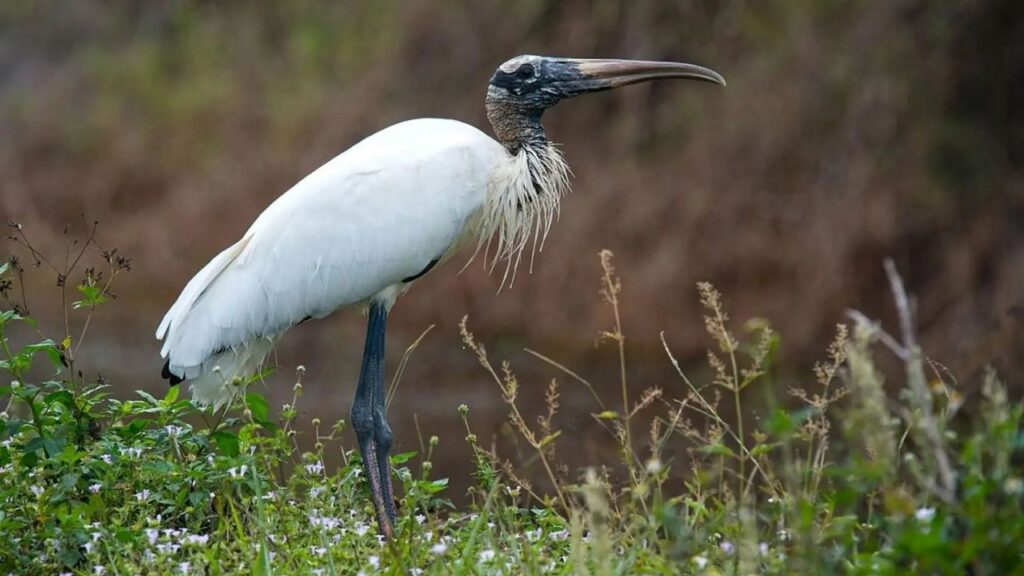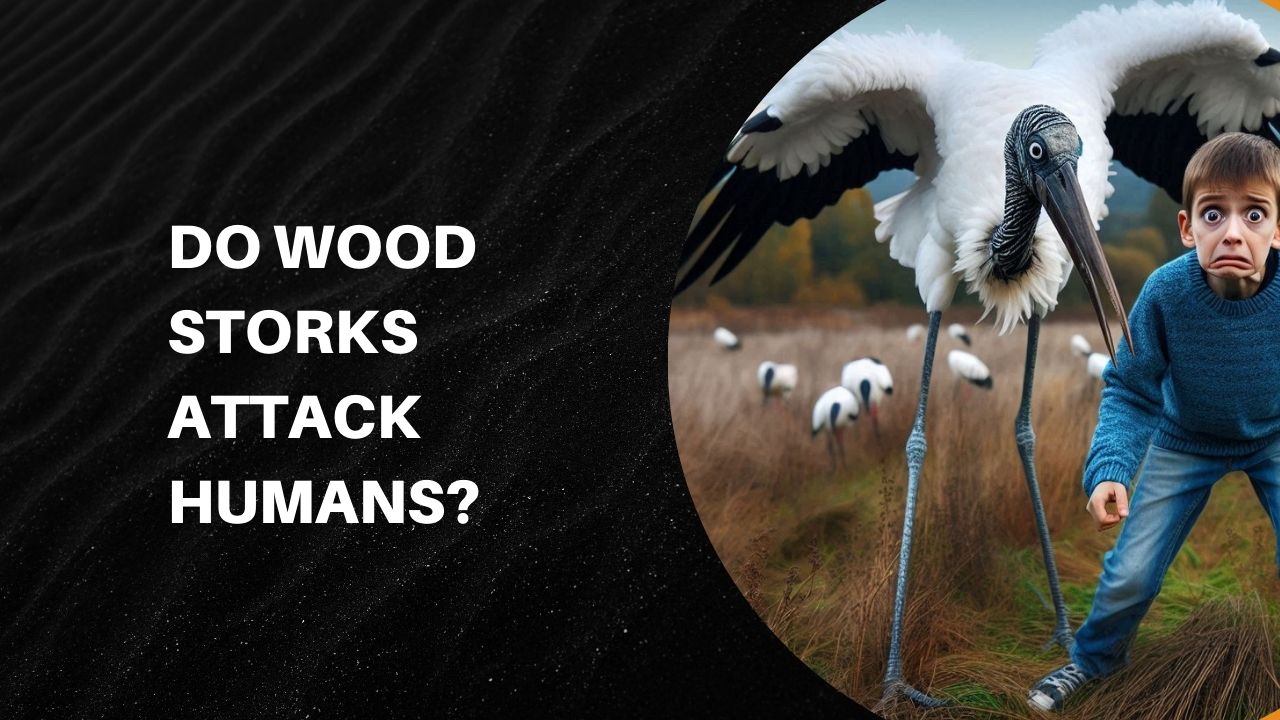Do Wood Storks Attack Humans? Wood storks are generally non-aggressive and pose no threat to humans. They are peaceful, solitary birds that focus primarily on fishing and foraging in wetland habitats.
When it comes to the world of wild birds, certain species have an intimidating look that may lead people to question their behavior toward humans.
The wood stork, with its distinct bald head and impressive wingspan, may appear formidable, but is it actually dangerous?
This article delves into the nature of the wood stork to address a common question: Do wood storks attack humans?
By exploring their habits, diet, and behavior, we’ll uncover the true disposition of this unique bird and provide helpful tips on safely observing them in their natural habitats.
Contents
What Are Wood Storks?
Appearance and Characteristics
Wood storks are striking birds with their own set of unique features. Known for their featherless, bald head and long, curved bill, these birds stand out among wetland wildlife.
Adult wood storks can reach a height of about 3 feet, with a wingspan of over 5 feet, giving them a remarkable presence in flight. Their bodies are mostly white with black-tipped wings, a feature that makes them easily identifiable.
Despite their powerful appearance, wood storks are primarily scavengers, not predators, and their looks are misleading when it comes to their behavior toward humans.
The wood stork’s distinct appearance serves a practical purpose. The bald, scaly skin on their heads and necks prevents feathers from becoming soiled while they forage in muddy waters.
This feature also helps them stay clean, as their primary hunting method involves dipping their heads into shallow waters. [Do Wood Storks Attack Humans?]
The long bill, curved at the end, acts as a sensitive tool, enabling them to detect and catch prey with high efficiency.
Natural Habitat and Behavior
Wood storks are native to the wetlands of North, Central, and South America, with a concentration in areas like Florida, Georgia, and the Carolinas in the United States.
They are primarily found in swamps, marshes, and other freshwater environments where fish, amphibians, and insects are plentiful.
These ecosystems are rich in resources, providing wood storks with an ideal setting for nesting and foraging. [Do Wood Storks Attack Humans?]
Wood storks are known for their calm demeanor, typically keeping to themselves and focusing on foraging in shallow waters.
Their solitary lifestyle means they rarely interact with other animals, including humans.
During nesting seasons, they may gather in small colonies but maintain a quiet, focused approach to life, avoiding disturbances whenever possible.
This peaceable behavior further emphasizes why wood storks are not a threat to human safety. [Do Wood Storks Attack Humans?]

Are Wood Storks Aggressive?
Wood storks are not aggressive birds and pose little to no threat to humans.
Unlike some territorial bird species that may become defensive if they feel threatened, wood storks are generally docile and uninterested in human activity.
They have no history of initiating attacks on humans and, in most cases, will ignore people altogether. [Do Wood Storks Attack Humans?]
Their nature is better suited to quiet observation and feeding, making them one of the more peaceful large birds to encounter in the wild.
While wood storks do have powerful bills that they use to catch fish and other small animals, these are tools for survival, not for aggression.
They may occasionally clash with other birds over feeding spots, but this is typical behavior for most bird species and is not directed at humans.
Unlike hawks or eagles, which have strong talons for gripping prey, wood storks rely on their bill as their primary tool, and they use it exclusively for gathering food from shallow waters.
A wood stork’s placid temperament also stems from its natural feeding and mating habits. Unlike aggressive predators, wood storks avoid confrontation unless absolutely necessary.
As long as humans respect their space and habitat, they are content to coexist peacefully without displaying any signs of aggression. [Do Wood Storks Attack Humans?]
Why Wood Storks Don’t Attack Humans
Diet and Feeding Habits
Wood storks feed mainly on small fish, insects, frogs, and other small aquatic animals. This diet keeps them focused on shallow waters rather than dry land, where humans are likely to be.
They use a method called “tactile foraging,” where they open their bills in water and snap them shut when they sense movement.
This patient, passive feeding technique further reflects their calm, non-confrontational nature. With no interest in meat or other food sources that would bring them into conflict with humans, wood storks maintain a low-risk lifestyle.
Wood storks use a unique method of foraging that’s highly efficient and minimizes energy expenditure. Their foraging technique involves moving their open bill through water and feeling for fish or small amphibians.
Once they detect movement, they close their bill within milliseconds, ensuring a quick and successful catch. [Do Wood Storks Attack Humans?]
This hunting style not only highlights their calm approach to life but also shows that they have no need to chase after prey, let alone pose any risk to humans.
Additionally, wood storks forage during specific times of day, often early morning or late afternoon, when fish and amphibians are most active.
By sticking to these periods, wood storks can avoid unnecessary interactions with humans who may be present in these areas at other times.
This natural separation in activity periods further reduces any chance of negative interactions. [Do Wood Storks Attack Humans?]
Interactions with Humans
In general, wood storks tend to avoid direct contact with humans, and cases of wood storks approaching or interacting aggressively with people are extremely rare.
In fact, wood storks are often seen calmly feeding in areas where humans are present, especially in protected wetland reserves and parks.
Observers note that wood storks are more likely to move away from humans rather than confront them, indicating a preference for solitude.
Wood storks are listed as a protected species in some areas, meaning they often reside in wildlife preserves or areas that limit human interference.
These protections help keep wood storks safe from harm and reduce their need to interact with humans. [Do Wood Storks Attack Humans?]
Encounters between humans and wood storks are, therefore, peaceful and rare, and they often occur in places where both parties coexist respectfully.
Safety Tips for Observing Wood Storks
While wood storks are not known to be dangerous, respecting their space is essential for both their well-being and yours.
Here are some helpful tips for observing wood storks in the wild:
Respect Their Space
Like all wildlife, wood storks should be observed from a respectful distance.
Crowding or attempting to touch them can cause unnecessary stress for the birds, and it’s important to remember that they are protected in certain areas.
Use binoculars or a camera with a zoom lens for a closer look without disturbing them. [Do Wood Storks Attack Humans?]
If you are observing wood storks in a nature reserve or park, be mindful of designated observation points and stay on marked paths.
These measures are in place to ensure that visitors do not disturb the birds or their habitats. Sudden movements and loud noises can scare them away, disrupting their natural feeding or nesting activities.
By maintaining a safe distance, you can enjoy their graceful presence without causing distress.
Do Not Feed Wild Storks
Although feeding birds may seem like a harmless act, it can disrupt their natural behavior and lead them to depend on human interaction for food.
Feeding wild storks can also introduce them to unhealthy foods that may impact their diet and health.
By avoiding direct feeding, you contribute to the preservation of their natural feeding behaviors. [Do Wood Storks Attack Humans?]
Feeding wild animals, including wood storks, can lead to other unintended consequences. Birds that become reliant on human-provided food may lose their foraging skills, reducing their chances of survival in the wild.
Additionally, food waste left by humans can attract predators or other invasive species that disrupt the natural balance of the ecosystem.
Therefore, it’s best to let wood storks follow their natural diet and feeding behaviors without interference. [Do Wood Storks Attack Humans?]
See Also: Do Blue Jays Attack Humans?
FAQs
1. Are wood storks dangerous to humans?
No, wood storks are generally not dangerous to humans. They are peaceful, non-aggressive birds that prefer to stay in wetland areas and focus on their own foraging activities. [Do Wood Storks Attack Humans?]
2. Can wood storks defend themselves if threatened?
While wood storks can defend themselves if directly threatened, they usually avoid confrontation. Their first instinct is to fly away or move to a safer area. However, they rarely need to defend themselves due to their calm nature and the protective environments they inhabit.
3. Is it safe to approach wood storks?
Approaching any wild animal should be done with caution, but wood storks are unlikely to react aggressively. Observing from a distance is recommended to avoid disturbing their natural behavior. As long as you maintain a respectful space, observing wood storks can be a peaceful experience.
4. What should I do if I encounter a wood stork in the wild?
Simply observe the wood stork from a safe distance. Avoid loud noises and sudden movements that might startle it, and refrain from attempting to feed or touch the bird. The less intrusive your presence, the more natural and fulfilling your observation will be.
5. How do wood storks contribute to their ecosystem?
Wood storks play an important role in wetland ecosystems by controlling fish and insect populations. They also serve as indicators of environmental health, as they rely on clean, well-balanced aquatic habitats. Their presence signals a healthy ecosystem, contributing to the biodiversity and stability of wetlands.
Conclusion: Do Wood Storks Attack Humans?
Wood storks, with their unique appearance and impressive wingspan, may look intimidating at first glance, but they are some of the most peaceful birds one can encounter in the wild.
These gentle wetland residents are harmless to humans, focused more on foraging and maintaining their habitat than on interaction with people.
Their calm feeding practices, preference for solitude, and non-aggressive nature mean they pose no threat to humans. [Do Wood Storks Attack Humans?]
Whether you encounter a wood stork in a park or a natural reserve, rest assured that they pose no threat, and by respecting their space, you can enjoy observing them as a part of the rich diversity of wetland wildlife.
Observing wood storks from a distance provides a unique opportunity to appreciate the beauty of these creatures without causing harm or disruption to their environment.

Hello, I am Rosa Ellis, a mother of two and a wildlife blogger. I grew up in New York City, but I love exploring forests. I’ve traveled to places like Yellowstone National Park and the Amazon Rainforest to see animals up close. I know a lot about animal behavior and which animals can be dangerous to humans. Thanks for visiting my blog!

